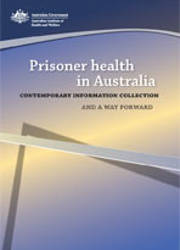Summary
With over 25,000 inmates held in custody at any one time in Australia, and about twice this number passing through Australian prisons each year, the need to plan health services to address the health needs of this disadvantaged group is paramount. The poor physical and mental health of this group is well established. With most returning to the community in a relatively short time, it is important to the overall health of the community that their health needs be addressed while in prison, and if possible improved.
The Australian Institute of Health and Welfare (AIHW) published a companion document to the current report in 2006 entitled Towards a national prisoner health information system. This report concluded that while their health needs are considerable, prisoners have been overlooked as a ‘special group’ within the community and nationally consistent information on prisoner health is required.
The value of prisoner health information
Planning effective health services requires reliable information on the health needs of the target group. Improving the availability of prisoner health information by implementing strategies like a national data collection or by introducing electronic health records brings benefits to patients, health care providers, the custodial system, government and the broader community. These benefits include:
- patient/prisoner
- time in custody will be used as an opportunity to maximise health potential upon release
- ability to share health information with community or external providers in an accurate and timely manner
- improved continuity of care upon entry and release from prison.
- health service provider
- improved access to required medical information
- improved access to statistical information for improved resource, health policy and treatment program planning
- ability to map and project demand for health services and identify emerging health or system issues
- improved efficiency (cost and time for file retrieval, auditing and complaints)
- ability to benchmark against other correctional health providers and other community providers.
- custodial provider
- better management of health conditions that affect custodial management.
- community
- identification and treatment of prisoner health problems that can impact upon the health of the general community (such as infectious diseases or unresolved mental illness)
- improved continuity of care upon release from prison.
- government
- access to statistical information for improved resource and health policy planning
- timely assessment of health services, health interventions and health policy.
Findings of the current report
In 2005, a Prisoner Health Information Group (PHIG) was established to progress the development of a national data collection for prisoners’ health. This report details the findings of the first stage of this process; a national audit of current health information collected by each jurisdiction.
Despite the needs of this group, there is remarkably little national information available on prisoners. Most health information is either collected through ad hoc surveys undertaken by a jurisdiction or is paper based and remains in medical records.
The major conclusion of the current report is that, while information is collected on prisoners—mostly at the point of reception—it generally remains paper based and is not collated either locally or nationally. Electronic information could be made available through the introduction of a ‘prisoner flag’ in some national data collections. Scant information is collected pre or post-release.
Where to from here?
Any national report on the health of Australian prisoners will require the implementation of new data collection processes and practices to garner this information. It is desirable that all jurisdictions move towards collecting comparable information at each stage of the incarceration process (reception, custody, release and pre-release) using national standards where available. Ideally this information would be made available electronically.
Greater standardisation could be achieved through the implementation of electronic health records using nationally agreed data standards. Data collections such as the National Prisoner Entrants’ Bloodborne Virus & Risk Behaviour Survey provide useful information on key areas affecting prisoners’ health and have the potential to be expanded to other areas such as mental health. Access to information during incarceration could be improved using models such as the Bettering the Evaluation And Care of Health (BEACH) survey which is used in monitoring general practice consultations.
This report lays the foundation for the next stage in the development of a national data collection for prisoners; the development of the actual health indicators. This will involve further consultation with state and territory prison health providers, policy makers and other stakeholders. Issues as to how best to collect this information will also be addressed as part of the next stage.



